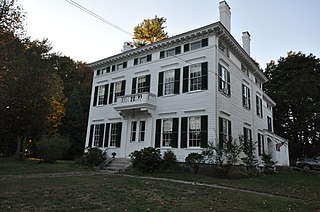
The Captain Reuben Merrill House is an historic house at 233 West Main Street in Yarmouth, Maine. Built in 1858, it is one of the town's largest and most elaborate 19th-century houses, and is one of three known surviving works of Portland architect Thomas J. Sparrow. It was placed on the National Register of Historic Places in 1974. It is now home to Maine Preservation, a statewide architectural preservation organization.

Yarmouth is a town in Cumberland County, Maine, United States, twelve miles north of the state's largest city, Portland. When originally settled in 1636, as North Yarmouth, it was part of the Massachusetts Bay Colony, and remained part of its subsequent incarnations for 213 years. In 1849, twenty-nine years after Maine's admittance to the Union as the twenty-third state, it was incorporated as the Town of Yarmouth.
The historical buildings and structures of Yarmouth, Maine, represent a variety of building styles and usages, largely based on its past as home to almost sixty mills over a period of roughly 250 years. These mills include that of grain, lumber, pulp and cotton. Additionally, almost three hundred vessels were launched by Yarmouth's shipyards in the century between 1790 and 1890, and the homes of master shipwrights and ship captains can still be found throughout the town.

Sparhawk Mill is a former cotton mill on Bridge Street in Yarmouth, Maine, United States. Built in 1840 and made of brick, it is home today to several businesses. The mill stands, just east of the town's Second Falls, on the site of several previous mill buildings, the earliest of which was a wooden mill dating to 1817.
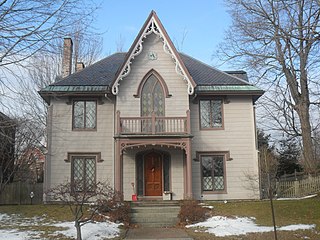
Henry Rowe was an Irish architect who practiced in nineteenth-century Massachusetts, New York and Maine. One of his most noted designs is The Gothic House, in the Spring Street Historic District of Portland, Maine, which was built in 1845. It is believed to be Rowe's first commission in the state, and is described in city promotional materials as the finest example of Gothic Revival architecture in Maine.
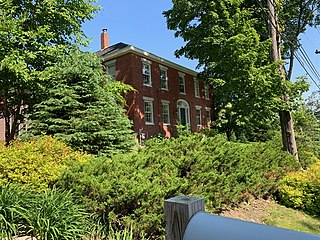
Pleasant Street is a historic street in Yarmouth, Maine, United States. It was formerly part of the Atlantic Highway, a precursor to U.S. Route 1. It connects to Lafayette Street, part of today's Maine State Route 88, at Pleasant Street’s southern and northern ends. It has existed since at least 1761, which is when a milestone was placed on the street, on the order of Benjamin Franklin, due to its being on the King's Highway, to denote its distance from Boston, Massachusetts. As part of his duties, Franklin conducted inspections of the roads that were used for delivering mail. One method of charging for mail service was by mileage, so Franklin invented an odometer to measure mileage more accurately. The King's Highway, as a result, morphed into the Post Road.

Main Street is a historic street in Yarmouth, Maine, United States. It is part of the 18-mile-long (29 km) State Route 115 (SR 115), the eastern terminus of which is in Yarmouth at the intersection of Marina Road and Lafayette Street (SR 88), at Yarmouth Harbor in the town's Lower Falls neighborhood. Main Street's western terminus is a merging with Walnut Hill Road in North Yarmouth, at which point SR 115 continues west. There are three distinct sections of Main Street : Lower Falls, Brickyard Hollow and Upper Village.

Captain Sylvanus Blanchard was an American merchant sea captain. A native of North Yarmouth, Maine, after retiring from the seas he became a noted shipwright, owner of one of the four main shipyards of Yarmouth harbor during the town's peak shipbuilding years of 1850–1875.
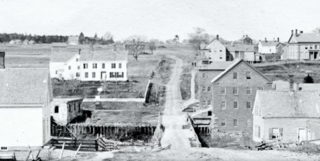
Bridge Street is a historic street in Yarmouth, Maine, United States. It runs for about 0.36 miles (0.58 km) from Willow Street in the north to the town's Main Street, State Route 115, in the south. The street's elevation is around 75 feet (23 m) at each end, while its middle section, at its crossing of the Royal River, is around 13 feet (4.0 m), a drop of around 62 feet (19 m).
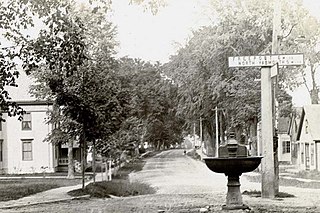
Elm Street is a prominent street in Yarmouth, Maine, United States. It runs for about 2.7 miles (4.3 km) from North Road in the north to Portland Street in the south. The street's addresses are split between "West Elm Street" and "East Elm Street", the transition occurring at Main Street in the Upper Village. Several of its buildings are homes dating to the late 18th and early 19th centuries.

Portland Street is a historic street in Yarmouth, Maine, United States. It runs for about 1.25 miles (2.01 km) from the town's Main Street, State Route 115, in the north to its merge with Middle Road in the south. It is so named because it leads to Portland, the state's largest city, after linking up with State Route 9 in Falmouth, Maine.

35 East Main Street, also known as the Jeremiah Baker House, is a historic four-storey home at 35 East Main Street in the Lower Falls area of Yarmouth, Maine. Between 1780 and the turn of the 19th century, Lower Falls saw an increase in its population after early settlers gradually moved inland from the area around the Meetinghouse under the Ledge on Gilman Road. Built in 1848, possibly for William Stockbridge, before Yarmouth's secession from North Yarmouth, the home overlooks Yarmouth Marina, which was a bustling working harbor from the early to late 19th century, and the area of the harbor historically known as Grantville. It stands adjacent to the Johnathan True House.

The Gilman Manse is an historic home at 463 Lafayette Street in Yarmouth, Maine. Built in 1771, making it one of the oldest extant buildings in the town, it was originally the home of Tristram Gilman, the fourth minister of the now-demolished Meetinghouse under the Ledge, which stood around 900 feet (270 m) to the northeast between 1729 and 1836. It succeeded the Cutter House, at 60 Gilman Road, as the parsonage for the church.

Hose No. 2 is a former fire station in the Lower Falls area of Yarmouth, Maine, United States. Built around 1889, seven years before the town's first fire hydrants were installed, it stands in a wedge-shaped plot of land separating Main Street and Marina Road at what was formerly known as Staples Hill. By 1901, the town had "two hose companies of fifteen men each" and a hook and ladder company of ten men. A system of fire alarms, consisting of eight boxes, were in the process of being installed.

The CaptainJoseph Drinkwater House is an historic home at 146 Gilman Road in Yarmouth, Maine, United States. Built in 1844, an architectural survey undertaken in 2018 found it had "important ties to Yarmouth history", for it was the home of the seafaring Drinkwater family for over a century.

Drinkwater Point Road is a prominent street in Yarmouth, Maine, United States. One of the first streets laid out in what was then coastal North Yarmouth, Province of Massachusetts Bay, it runs for about 0.45 miles (0.72 km) from Gilman Road in the north to Seaborne Drive in the south. Drinkwater Point faces Cousins Island, to which it is connected by the Ellis C. Snodgrass Memorial Bridge, and overlooks inner Casco Bay.

Church Street is a historic street in Yarmouth, Maine, United States. It runs for about 425 feet (142 yd) from West Elm Street in the east to Hillside Street in the west. It was one of the first streets laid out after the town's population moved inland from the Broad Cove area in the 19th century. Several of its buildings are homes dating to the late 18th and early 19th centuries.

Brickyard Hollow is the central section of Main Street in Yarmouth, Maine, located between the Upper Village to the northwest and Lower Falls to the southeast. It is named for the brick-making business that was located across the street from the Masonic Hall at 189 Main Street, beneath the U.S. Route 1 overpass, which was built in the 1870s.

Lower Falls is the colloquial name for the eastern end of Main Street, and part of East Main Street, in Yarmouth, Maine, centered around Main Street's intersection with Portland Street. It is also known as Falls Village or The Falls.

Staples Hill is a historical section of Main Street in Yarmouth, Maine. It is located, in what is known as Lower Falls, at Main Street's split with Marina Road. Main Street continues on, down a substantial hill, to First Falls, while Marina Road leads, in a similar fashion, toward Yarmouth Marina, where ships were built between the late 18th and late 19th centuries. Today, both roads join State Route 88 around 450 feet (140 m) apart; historically, however, they provided access to the harbor from the town. The section of Route 88 between the intersections was formerly known as Grantville.




















